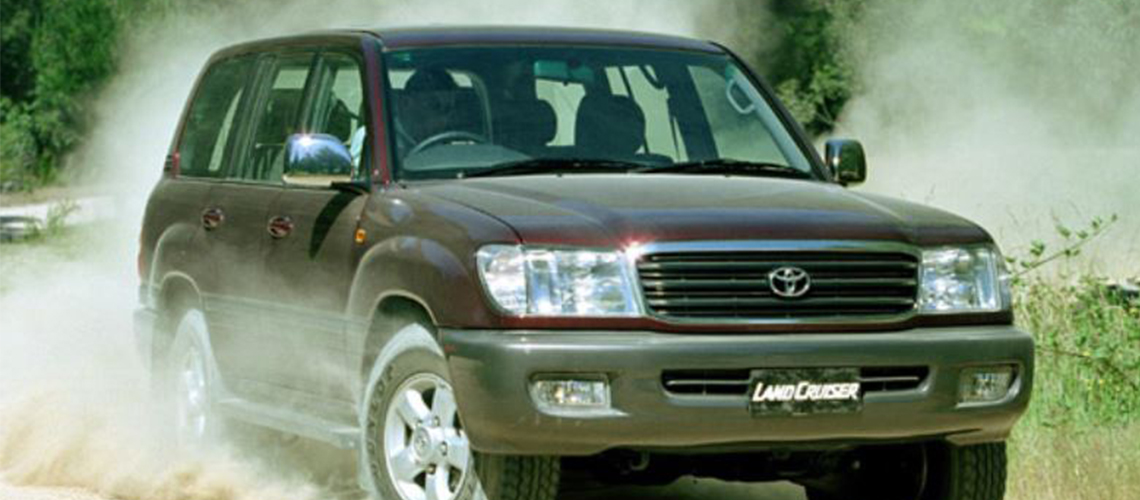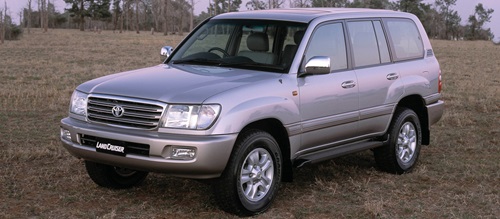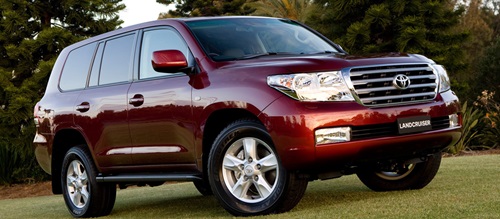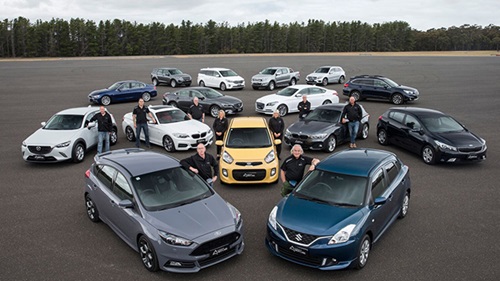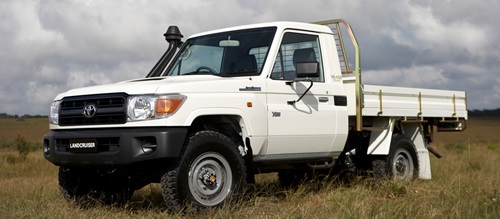Specifications |
|
| Priced from | $47,460 |
| Engine | 4.5; 4.6 L |
| Transmission | |
| Fuel Economy |
14.6 L/ 100km
|
| Output | 165 kW @4600 rpm/ 170 kw @ 4800 rpm/ 387 Nm @3600/ 410 @ 3400 rpm |
| ANCAP rating |
Not Tested |
Just when the opposition seemed to catch up, Toyota took another jump forward with its new 100 Series LandCruiser, and has set new standards for which its opponents can strive.
Along with some very obvious changes in the styling of the all-new 100 Series, Toyota has introduced a new power plant to its model line-up, changed some of its model designations and improved general performance and comfort levels.
The 1998 range consists of eleven models: ten six cylinder versions, and one V8. The basic Standard model can be purchased with either diesel or petrol six cylinder engines, both with manual transmission only. RV and GXL models have either six cylinder petrol or diesel engines with a choice of manual or automatic transmission, and the GXV has the new petrol V8 in automatic transmission only.
The starting price for the 100 series is $47,460 for the Standard six cylinder petrol wagon, and the most expensive GXV V8 automatic wagon is $89,000. Air conditioning is standard in only the top of the line GXV and an option in all other models at $2,569. Anti-skid brakes (ABS) are standard on GXL and GXV, but optional on RV at $1000, and Dual Airbags (SRS) are standard on GXL and GXV, but optional on Standard and RV models at $1490. Our test Standard model with air conditioning and fabric seats, and the GXV with optional moonroof, were priced at $50,329 and $92,020 respectively.
Features and equipment
The 4.5 litre six cylinder petrol engine has been given a revised cylinder head and exhaust system to boost the torque and power output even further. The 4.2 diesel engine has also been modified and is no longer available with a turbocharger. The combination of a new cylinder block, crankshaft, pistons, combustion chamber and injectors has resulted in an increase in torque, improved emissions and still further noise reduction.
Most of the attention has been directed at the new 4.7 litre V8, which is a development of the 4.0 litre Lexus LS 400 engine, which has received many accolades in that form. With an increase in capacity, and two camshafts per bank operating four valves per cylinder, this would be the most advanced, high tech engine used in an off-road vehicle. However, for all this effort, it produces just 5 kW and 23 Nm more than the six cylinder petrol engine.
Toyota claims increased strength and durability in all its transmission assemblies and this follows through to the transfer case and the drive axles. The front and rear suspension in the Standard through to GXL is basically the same as the 80 Series with some minor modifications. The GXV, however, whilst utilising the same rear suspension as all other models, has adopted an independent suspension with double wishbones and lower torsion bars in the front. Rack and pinion steering is also part of the GXV's front end package.
Four piston front brake callipers have been reintroduced on all models, and the front discs have been increased in diameter. ABS models use the Lexus type hydraulic booster, incorporating the actuator, booster and proportioning valve in the master cylinder.
Anti-lock brakes, air bags and impact absorption areas of the body and chassis are the main safety features of the 100 series. Many other smaller safety items make it an all round safer vehicle than its predecessor.
All models are fitted with an engine immobiliser with a transponder fitted in the ignition key, and are prewired ready for the optional Toyota Vehicle Security System (TVSS).
Body and finish
Though appearing to be similar in body shape and size, the 100 series Cruiser is slightly longer, wider and higher than the 80 series. Previous add-on wheel arch flares have been discarded and incorporated in the guard panels. Panel and paint finish is excellent, although in our test vehicles, colour did not extend into the engine compartment.
Front end styling has been upgraded to feature a new grille, bumper, bonnet line and large, single, square headlights. Large rear lights that wrap around into the tailgate, a high-level stoplight mounted externally at the top of the tailgate and a new bumper complete the rear treatment.
Comfort and space
Front and middle row seating is quite comfortable with adequate head and leg room for most people. Third row seating when fitted, however, is fairly cramped and suitable only for small adults or children. The middle position in the front of the Standard is an occasional seat only.
Storage is limited in the rear when the third row seating is in place and when folded against the side. However, as they are removable, full use of the rear space can be utilised. Standard models have a large uncluttered luggage area behind the rear seat. Eight seater models have a generous two stage centre console glovebox in addition to the regular glovebox and door pockets.
Dual controlled Climate-Control air conditioning is standard in the GXV whilst manually controlled air is optional in all other models.
Behind the wheel
Seated behind the wheel of the 100 Series, one has a definite feeling of control and comfort. All-round vision from this position is very good, hampered only by the rear head restraints and the third row seats when folded. However, this is not a problem in the more basically equipped Standard model.
Though undeniably big and heavy, the new Cruiser does not feel cumbersome when being driven. The steering and all controls are light and easy to operate, feeling more like a sedan car.
Full instrumentation including a large tachometer is standard on all levels. Two separate 12 volt sockets are provided for accessory use.
On the road
Both the 4.7 litre V8 and the 4.5 litre six were very smooth and quiet with performance to match, although these features are not without penalty, as fuel consumption is quite high on both petrol engines. I would have to question the wisdom of owning a GXV V8 when the six cylinder petrol engine is likely to give better fuel economy, and the engine power and torque is only marginally lower.
The four speed automatic transmission has a power/economy feature, while a '2nd' button allows the vehicle to start off in second gear for those slippery surface situations. Gear changes are almost undetectable, and ratios are well spaced. The manual box is a little notchy and truck-like, but easy to use, and whilst first gear is quite low, it is very useful for ascending or descending those steep pinches off-road.
Handling on all road surfaces has certainly improved, with stability and predictability being the key features. The narrow wheels and tyres fitted to the Standard made an obvious difference to the on-road handling, with inferior grip compared to the 275/70R16's on the GXV.
Braking distance is excellent for a vehicle of its size and mass, and as expected, quite a deal of heat and a subsequent small increase in pedal pressure is generated in bringing this 2.4 tonne mass repeatedly to a halt during our brake fade test.
Off-road
Anti-lock brakes combined with a stable ride and handling package, make this vehicle a capable off-road performer. However, in the more severe situations the independent front suspension has its limitations with wheel travel, and the auto transmission is lacking in engine braking.
As all other models including the Standard retain the 80 series suspension design, with some modifications, wheel travel is excellent and engine braking with the manual transmission is maintained.
The Dunlop Grand Trek tyres, whilst offering good on-road performance, offer little grip in mud or sand.
Servicing
Once the plastic cover on top and the large splash tray under the V8 engine are removed, access to serviced items is improved, however, general access is not good The six cylinder engine compartment is a more service friendly environment with good accessibility.
Service intervals are recommended every 10 000 km with major services set at 20 000 km. Warranty is now fixed at 3 years or 100 000 km, without the separate periods for drive trains, etc that existed previously.
Undoubtedly Toyota LandCruisers will be purchased with towing in mind, and the 100 Series should not disappoint in this area. Toyota's recently increased towing capacity of 3500 kg has been retained in the 100 Series, but for the time being, NSW owners will have to be content with the regulation 2185 kg for the GXV and 2130 kg for all other models.
Summary
If big, with the ability to go most places on or off-road, is what you need, it is hard to go past the LandCruiser 100 series wagon. With the improvements included in this latest model, coupled with a freeze on last year's pricing, it certainly warrants a high position on the large 4WD wagon priority list.
If you want the ultimate in comfort on and off-road, you can choose the more luxurious GXL or GXV models, but if it is a more practical, go anywhere performance you need, without the fancy bells and whistles, you can consider the Standard or RV levels, with manual transmission.







